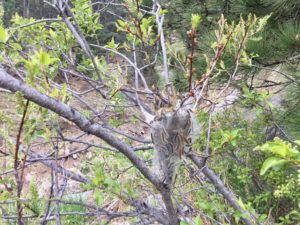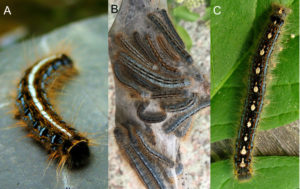Bud break doesn’t just mean the arrival flowers and leaves, it also means tent caterpillars begin to hatch. Within a few weeks, troops of these caterpillars can cover tree branches with their silk tents. So, should you be concerned about them? Read on to find out!

A typical western tent caterpillar tent. These tents can usually be found in the crooks of major branches on trees and medium sized shrubs.
What are they?
You may encounter three species of tent caterpillar in Indiana: Forest tent caterpillar (Malacosoma disstria), Western tent caterpillar (M. californicum), and eastern tent caterpillar (M. americanum). All three species live in groups of anywhere from 40 to 200 individuals that stay together until shortly before they pupate. Western and eastern tent caterpillars both build tents that they live in between food runs (figure 1) whereas forest tent caterpillars roam in groups without a home tent. They are loosely social and will lay down pheromone trails to branches that are good food sources.
Look-a-likes
Although their tents can make them distinctive, there are several other species of caterpillars that tent caterpillars can be confused with. Here are a couple of tricks to telling them apart from other species. First, check if the caterpillar you’re looking at is fuzzy. All tent caterpillars are covered in fuzzy hairs, so if it’s smooth or spikey it’s not a tent caterpillar. Next, check for big tufts of hair at either end of its body. Tent caterpillars lack these tufts. Finally, check for either a stripe (eastern and western tent caterpillars) or a line of penguins (forest tent caterpillars) on its back (figure 2). If the caterpillar you’re looking at lacks any of these traits, it’s probably not a tent caterpillar.

A. Eastern tent caterpillar have a distinctive white stripe down their backs, B. western tent caterpillar are slate blue with a pair of black stripes, and C. forest tent caterpillar have a pattern of dots on their back that resemble penguins or bowling pins. Image credits: A. Ashley Waldron B. Elizabeth Barnes C. Audrey R. Hoff
What do they eat?
All three species of caterpillars eat a wide range of plants, particularly later in the spring. They especially favor plants in the Rosaceae family like cherry, apple, and chokecherry. As the spring progresses and the caterpillars get bigger, they will move onto a wide range of other deciduous plants.
What damage do they do?
Although some people may find them unsightly, in most years tent caterpillars do not cause serious injury to their host plants and can even be beneficial to their environment by providing a food source for wildlife. Typically, tent caterpillars only defoliate a few branches and only actively feed for a few weeks. Even in outbreak years when they can fully defoliate small trees, most plants are able to bounce back to health after the caterpillars have moved on. However, if the tree is defoliated multiple years in a row or is dealing with another stress like drought it may lose branches or even die. See this PLR article to evaluate the potential impact of defoliation on your tree.
If you do wish to remove tent caterpillars from your trees, there are a wide range of options available to you. One of the easiest ways to get rid of tent caterpillars is manually removing them. Wait until most of the caterpillars are in their tent and then simply pull the tent off the tree, place it in a bag, and freeze it. Tent caterpillars leave their tents multiple times a day to feed so your best chance for catching them all in their tent is a night. You may want to wear gloves to remove them from their tree because some people have an allergic reaction to their hairs. In addition, most of the options described in this article for treatment of fall webworms will work for tent caterpillars (make sure to double check label instructions).
If you think you’ve found some tent caterpillars but aren’t sure, feel free to reach out to the author or post it on iNaturalist or BugGuide for ID help!